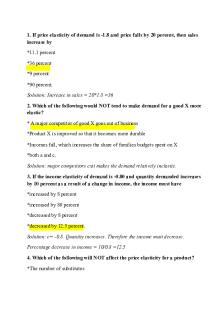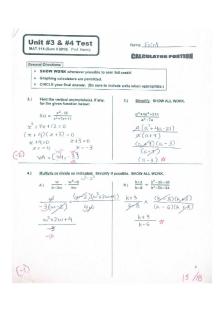Answers to Moodle test PDF

| Title | Answers to Moodle test |
|---|---|
| Course | Economics |
| Institution | Christ (Deemed To Be University) |
| Pages | 8 |
| File Size | 196.3 KB |
| File Type | |
| Total Downloads | 84 |
| Total Views | 159 |
Summary
Download Answers to Moodle test PDF
Description
1. If price elasticity of demand is -1.8 and price falls by 20 percent, then sales increase by *11.1 percent *36 percent *9 percent *90 percent. Solution: Increase in sales = 20*1.8 =36 2. Which of the following would NOT tend to make demand for a good X more elastic? * A major competitor of good X goes out of business *Product X is improved so that it becomes more durable *Incomes fall, which increases the share of families budgets spent on X *both a and c. Solution: major competitors exit makes the demand relatively inelastic. 3. If the income elasticity of demand is -0.80 and quantity demanded increases by 10 percent as a result of a change in income, the income must have *increased by 8 percent *increased by 80 percent *decreased by 8 percent *decreased by 12.5 percent. Solution: e= -0.8. Quantity increases. Therefore the income must decrease. Percentage decrease in income = 10/0.8 =12.5 4. Which of the following will NOT affect the price elasticity for a product? *The number of substitutes
*How long consumers have to adapt to price changes *The cost of producing the product *The percentage of consumers' budgets spent on the product *All of the above will affect the elasticity of demand for a product. Solution: Cost of producing affects elasticity of supply, not demand. 5. When the quantity of coal supplied is measured in kilograms instead of pounds, the demand for coal becomes *more elastic *neither more nor less elastic *less elastic *undefined. Solution: The unit of measurement does not impact elasticity. Elasticity is relative to determinants of demand and not the unit of measurement. 6. If a rightward shift of the supply curve leads to a 6 percent decrease in the price and a 5 percent increase in the quantity demanded, the price elasticity of demand is *0.83 *0.30 *0.60 *1.20. Solution : Price elasticity of demand = % change in quantity demanded / %change in Price = 5/6 =0.83 7. Suppose that the quantity of root beer demanded declines from 103,000 gallons per week to 97,000 gallons per week as a consequence of a 10 percent increase in the price of root beer. The price elasticity of demand is
*1.66 *6.00 *0.60 *1.40. Solution: % change in demand = (103000-97000)/103000 *100 = 5.82% Price elasticity of demand = % change in quantity demanded / %change in Price = 5.82/10 =0.582 =0.6 approximately 8. On a straight-line downward-sloping demand curve, the maximum elasticity of demand occurs *where it intersects the supply curve *at its vertical intercept *at its horizontal intercept *at its midpoint. Solution: At the top-left of the curve (Vertical intercept), where the price is high and quantity is small, a $1 price change is relative small, while a 2-unit quantity change is relative large. Hence the elasticity (relative quantity change divided by relative price change) is “large” divided by “small”, hence is very large (in absolute value).
9. Of the following, demand is likely to be the least elastic for *Pink grapefruit *Iceberg lettuce *Insulin for diabetics *Diamonds. Solution: prescription medicine are likely to be price inelastic as they are necessities and have few substitutes, 10. A 10 percent increase in income causes the quantity of orange juice demanded to increase from 19,200 to 20,800 gallons. The income elasticity of demand for orange juice is *0.8 *1.2 *1.0 *0.5. Solution: Income Elasticity = %change in demand / % change in Income % change in demand =(20800-19200)/19200 *100 = 8.3% Income Elasticity =8.3/10 = 0.83 or 0.8 11. Of the following, which one is most likely to have a negative income elasticity of demand? *Shoes *Tennis balls *Inter-city bus travel *Frozen yogurt.
Solution: As a consumer’s income increases, he may want to use less and less of Public transport. Therefore, it has a negative income elasticity. 12. A rise in the price of cabbage from $14 to $18 per bushel, caused by a shift of the demand curve, increases the quantity supplied from 4,000 to 6,000 bushels. The elasticity of supply is *1.7 *1.0 *0.6 *0.8. Solution: Elasticity of supply : % Change in supply / % change in Price % change in Supply = (6000-4000)/4000 *100 =50% % change in Price =(18 -14)/14 *100 = 29% =50/29 = 1.72 13. A fall in the price of X from $12 to $8 causes an increase in the quantity of Y demanded from 900 to 1,100 units. What is the cross elasticity of demand between X and Y? *2 *-0.6 *-2 *0.6. Solution: Fall in price causes an increase in demand of the related good. Therefore, the cross elasticity is negative. Change in Quantity = (1100-900)/900 *100 = - 22.22% Change in Price = (12-8)/8 *100 = 50% Cross Elasticity = 22.22/50 = -0.44. Closest answer option =-0.6
14. Which of the following is a characteristic of a commodity whose demand is inelastic? *There are a large number of good substitutes for the commodity *The buyer spends a small percentage of his total income on the commodity *The commodity is regarded by the consumer as a luxury *The period of time for which the demand is given is relatively long. Solution: The lesser the percentage of income spent on a commodity, the lower the price elasticity. 15. If supply is inelastic and demand decreases, then the total revenue of the seller will *increase *decrease *decrease only if demand is elastic *increase only if demand is inelastic. 16.Average income increases from Rs20,000 p.a. to Rs22,000 p.a. Quantity demanded per year increases from 5000 to 6000 units. Which of the following is correct? *Demand is price inelastic *The good is inferior *Income elasticity is -2 *The product has a positive income elasticity of demand. Solution: Since the increase in income is causing an increase in quantity demanded, the income elasticity is positive. 17. The income elasticity is +2 and income increases by 20%. Sales were 5000 units, what will they be now?
*3000 *7000 *5500 *4500. Solution= Since elasticity is +2, a 20% increase in income causes a 40% increase in sales. Therefore the new sales amount = 5000*140/100 = 7000 units 18. The bus fare charged by the local bus company is Rs2.00 during the morning rush hour, but only Rs1.50 during the early afternoon. This can be explained by the fact that the demand for bus rides during the morning rush hour is _____; but during the early afternoon the demand for bus rides is _____: *perfectly elastic; perfectly inelastic *less elastic; more elastic *perfectly inelastic; relatively inelastic *unit elastic; inelastic *more elastic; less elastic. Solution: Since an increase in price (fare) does not reduce the number of people using the service (indicated by the word ‘rush hour’), demand in the morning can be considered as relatively inelastic. The reduction in the fare by afternoon indicates that, inorder to keep demand from falling, price cut is essential. Hence, demand in the afternoons is relatively elastic. 19. The government wants to reduce the consumption of electricity by 5%. The price elasticity of demand for electricity is 00.4. The government should: *raise the price of electricity by 0.8% *raise the price of electricity by 2% *lower the price of electricity by 0.4%
*lower the price of electricity by 12.5% *raise the price of electricity by 12.5%. Solution: Price elasticity is 0.4. Price and demand are always negatively related. Therefore, if the Government wants to reduce demand, it has to increase price. The target reduction is 5%. Therefore, the increase required in price = 5/0.4 = 12.5% 20. If the government is seeking to raise revenue by increasing the rate of indirect tax on a product, it will be most successful where price elasticity of demand is: *relatively inelastic *perfectly elastic *perfectly inelastic *unit elastic *relatively elastic. Solution: When the demand is perfectly inelastic, any increase in price does not change the demand, hence leads to an increase in Total Revenue....
Similar Free PDFs

Answers to Moodle test
- 8 Pages

PR Moodle Test Lösungen
- 51 Pages

Externes Rechnungswesen Moodle Test
- 13 Pages

Test eco ll 3 - test de moodle
- 4 Pages

Moodle
- 9 Pages

How to log in Moodle 2
- 1 Pages

Test, answers
- 12 Pages

Test, answers
- 10 Pages

Canonico Moodle
- 125 Pages

Unit 3 test - test answers
- 8 Pages
Popular Institutions
- Tinajero National High School - Annex
- Politeknik Caltex Riau
- Yokohama City University
- SGT University
- University of Al-Qadisiyah
- Divine Word College of Vigan
- Techniek College Rotterdam
- Universidade de Santiago
- Universiti Teknologi MARA Cawangan Johor Kampus Pasir Gudang
- Poltekkes Kemenkes Yogyakarta
- Baguio City National High School
- Colegio san marcos
- preparatoria uno
- Centro de Bachillerato Tecnológico Industrial y de Servicios No. 107
- Dalian Maritime University
- Quang Trung Secondary School
- Colegio Tecnológico en Informática
- Corporación Regional de Educación Superior
- Grupo CEDVA
- Dar Al Uloom University
- Centro de Estudios Preuniversitarios de la Universidad Nacional de Ingeniería
- 上智大学
- Aakash International School, Nuna Majara
- San Felipe Neri Catholic School
- Kang Chiao International School - New Taipei City
- Misamis Occidental National High School
- Institución Educativa Escuela Normal Juan Ladrilleros
- Kolehiyo ng Pantukan
- Batanes State College
- Instituto Continental
- Sekolah Menengah Kejuruan Kesehatan Kaltara (Tarakan)
- Colegio de La Inmaculada Concepcion - Cebu





